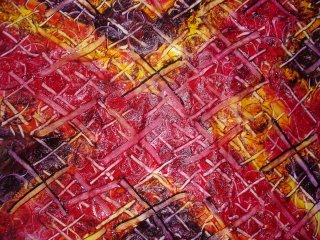
I have been playing around with the idea of crosses- how to incorporate them into some pieces I have in mind to record my reaction to my visit to palestine. Of course the crosses or cross stitches derive from the palestinian embroidered dresses ( which is also practised in other parts of the region- and the dress I have is Syrian) and I am intrigued by the eveness of the stitching. I painted this piece of fabric using the African method but am not that happy with it- I liked what happend but am not enthused by the colour- I think it would have been better with another colour underneath overlaid with darker colours. Stitching will off course pop out elements, but it still needs more playing with and thinking about.
Last week Omega on her blog explored why she worked in textile and made some interesting observations, and for me it has to be stitching. I left a comment to her post and Omega responded with this:"Everything has been worked upon, specially decorated and elaborated over and above the basic cloth itself. Traditional embroidery is the overlaying of cultural significance onto bare everyday necessity. These embroideries tell us so much about the peoples whose traditions and beliefs they illustrate." from an article she had written regarding Sheila Paine's embroidery collection. And i do so agree , but there is another aspect and that is the cross as the mark of the illiterate person- why is it a cross? Why not a triangle or two parallel strokes? I suppose the cross is likely to be slightly different in each hand but on the other hand it is the ultimate sign of free will by recording agreement when the cross mark is placed.
And yesterday my ETN magazine arrived - it was somehow disappointly sparse ( though I will have another look). The 3rd European Quilt Triennial was reviewed by Beatrijs Sterk and she comments that there has been symptons of fatigue in analysing Quilt National in the US and signs of stagnation and decline in participation in European quilt events. I think she misses one issue however- there seems to be a regularity to the works selected ( even when another medium juror is used) a certain uniformity- so that the same names recurr and recurr with a few new names . In all my travels I am seeing lots of different work- some very good and it is not being selected.I am not sure that we are seeing the 'edgy' work for which she yearns or work that is designed in a different manner. Sterk seems to think that the medium would benefit from an injection of teaching from other art mediums, but after my experience with my masters I am not sure, what would come from there?- everything has been pushed to the conceptual to such an extent that there is no room for the contemplation of the idea textile let alone its manifestation.I think to work in textile is to accept that it is textile ( and I use the word advisedly- if I wanted a wider ranging word I would have used fibre) and as such there qualities which can be explored/touch , hapticity, shrouding, folding, stitching. I think one problem with making contemporary quilts is that we are looking for the wall as the medium of its display whereas there are many other ways of interacting with a quilt and a major one is touch- how many people have I not seen try and rub that quilt between forefinger and thumb? I have often felt like curating an exhibiton entitled "off the wall and onto the bed"- if you had to spend a year in a bed what would such a piece consist of for you?

1 comment:
Thanks for sharing. There's so much in this post to contemplate. I really like your idea of taking textiles back off the wall. It is, to me, all about the touching. I recently showed my work at a community craft show. It was far from an art show, and there were lots of families with kids. Most had never seen an "art quilt." I didn't have the heart to tell people not to touch these precious works of mine because I really feel that touching the fabrics and embellishments is part of the experience of the art. Seeing peoples responses to the tactile experience far outweighed the archival issues associated with toching.
Post a Comment